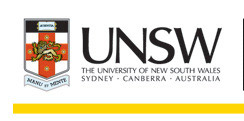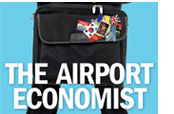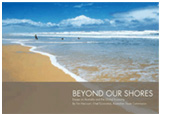The Paradise of Diversity – why Trade, Investment, Migrants are all bound for South Australia
By Tim Harcourt*
Something happened to South Australia this year that didn’t surprise me but may have surprised some doubters in the eastern states and maybe even some cynics back home.
The world renowned documentary maker, National Geographic chose Adelaide to lead its 21st century cities programme. Of all the cities in the world, and all the cities in Australia (many of who are much larger and economically more influential) Nat Geo went for Adelaide. And not only was Adelaide the leading city in Australia to front the programme but National Geographic invited Adelaide to lead the world.
So why did they choose Adelaide? Nat Geo wanted to pick a city that had globally connected businesses – like Coopers and Penfolds, and globally connected individuals like Scott Hicks and Shane Yeend. But it also wanted to pick a city that had a certain creative energy, that invested in education and the quality of life, was connected (with free Wi-Fi in the city), and had a smart approached to public transport and was coping well with climate change in terms of urban design and logistics.
Of course a visit to Adelaide helped with the impressive new sky line – the new Adelaide Oval, the ‘Cheese grater’ (the SA health and medical research institute building), the museums and monuments of north terrace and Colonel light’s green belt (the parklands around the city was almost like nature’s air conditioner was the comment of one of the Nat Geo visitors).
And of course it wasn’t just the city’s physical infrastructure that impressed Nat Geo it was the people that made the city too. The US academic Richard Florida has written about ‘creative capital’ and the tendency of cities with strong cultural industries and cultural diversity and tolerance to do better than cities that are homogeneous and intolerant without a big arts scene. And this influenced Nat Geo’s thinking about choice of city for the 21st cities documentary. They wanted to choose a vibrant city and Adelaide was perfect for them with live music, small bars, lots of international students and young people in the CBD and a strong cultural creative scene. Part of their trip coincided with “Mad March” and they soaked up the Fringe, the Festival of Arts, WOMAD and the Adelaide Writers Festival and they were impressed with how well Adelaide could put on a major international motor racing event like Clipsal whilst simultaneously running major arts festivals. They heard that Adelaide was the ‘Creative Capital’ of the nation, and we certainly delivered in spades.
And finally then there was the quick access that Adelaide brings. In a matter of a couple of weeks of finding out Adelaide was interested, NatGeo flew into Adelaide’s international airport with ease to see the Premier Jay Weatherill and together with the strong early support of dynamic Adelaide Lord Mayor Stephen Yarwood things happened instantaneously. Nat Geo was impressed with how well the South Australian Government, the City of Adelaide and the Economic Development Board lead by Raymond Spencer could make things happen so easily and smoothly.
So whilst the headlines about Holden dominated (and given the plight of so many car workers and small businesses affected they should) South Australia was getting on with creating new industries and new jobs for a post Holden future. The National Geographic documentary is a good way to showcase the many things happening in Adelaide across industries and across borders. Adelaide is a globally connected, modern city with an outstanding commitment to education, social reform and a good quality of life for all its citizens.
That’s why we have the great “Generation Export” companies like Ellex, Redarc, Seeley International, Biosa, Techport Amigo, Laucke Flour Mills, Rossiters, Wallcann, Era Publications, Ceberus Sciences, Precise Advance manufacturing Group, Amorini Australia, APC technology, Norman Sheun Architects joining the likes of our icons RM Williams, Haighs, Beerenberg, Coopers, Maggie Beer, Wolf Blass and Penfolds all doing things globally from their local base in South Australia. You meet all these proud South Australian Generation Exporters off shore when traveling as an airport economist. I have witnessed Michell process wool in Shanghai, Film maker Shane McNeil make productions in Shandong China and have seen a double act by Penfolds Wine maker Peter Gago and SA master chef Steve Baker put on a premium wine and food show in Shanghai. Not to mention running into our young McLaren Vale wine makers taking their technology and skills to Mendoza, Argentina.
And there’s also “Generation Expat” South Australians doing well from South London to South Mumbai Shanghai Santiago and Sao Paulo. Like entrepreneurs Anthony Ceravalo of ECNLive, Lance Stewart of Wavana, Andrew Grill of Kred and Lyndon Gasking of Get lunched.com. And people like Amanda Stranks, from Oxford University, Hugh Bailey from Macquarie, Emma Kate Codrington, a young Adelaide designer. Of course many come home, like Andrew Hough who returned to The Advertiser after getting many scoops on Fleet Street and many keep in touch via the SA Government’s “Generation Expat” linked in site for job opportunities, news from home and general conversation about the future of South Australia.
And whilst many young South Australians look for career experience (and a good time!) beyond our shores, we are also getting the benefits of new talent coming to the state. South Australia is receiving the benefits of immigration and cultural diversity. Just a stroll down the Central Market during Chinese New Year can tell you that the city is thriving with international students – there are almost 30,000 in South Australia now compared to just over 11,000 a decade ago – from China, India, ASEAN and increasingly the Middle East, Europe, Africa, Latin America and emerging markets. Over 1 in 5 South Aussies are born overseas, and 50 per cent of our exporters and 2/3 of our entrepreneurs are immigrants. When the boat comes in, or in modern times the plane, we all benefit as an economy and a society.
I wrote in recent piece that South Australia was called ‘The Paradise of Dissent’ in the 19th century but I think given the multitude of opportunities across industries from advanced manufacturing to creative industries, and the influx of creative talent from Asia means South Australia can be called ‘The Paradise of Diversity’ in the 21st century. And that’s why you have a world class film maker like National Geographic choosing Adelaide, South Australia to head their prestigious documentary series about the world class globally connected but liveable cities of the 21st Century.
*Tim Harcourt is the JW Nevile Fellow in Economics at the Australian School of Business, UNSW and author of The Airport Economist: www.timharcourt.com
Raised in Adelaide, he is the Adviser – International Engagement for South Australia












